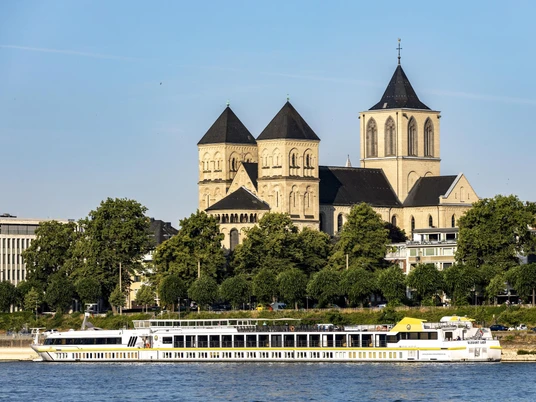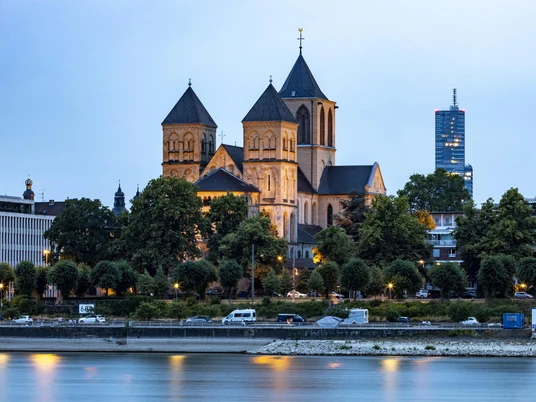- Photos & Map
How would you like to arrive?
- Call
- Details
- Useful Information
- Nearby
In many ways Cologne is somewhat different from other cities, including childbearing, because according to legend, the cute little ones are not delivered by the stork but rather emerge from the Kunibertuspütz, a deep well beneath the church of St. Kunibert. You can visit this well during your visit, along with more definitively documented treasures: colorful original windows from 1230, a five-armed bronze chandelier from the 15th century, relics of the two Ewaldi Saints, as well as remnants of medieval wall paintings and much more.
The fact that this Romanesque church stands today is nothing short of a miracle, as St. Kunibert has been subjected to numerous destructive events over the centuries and has only been reconstructed since 1993. But let's dive directly into the church's history...
In the following centuries, parts of St. Kunibert were repeatedly destroyed by fire, lightning strikes, general deterioration, storms, and not least, World War II. Each event was often followed by reconstruction in different architectural styles. This can be seen, for example, in the west portal created by the sculptor Toni Zenz in a style of gentle expressionism.
Let's take a closer look at some of these destructive events: In 1376, a major fire broke out, melting the roof's lead, crashing the bells, and piercing the vault. The cloister and several collegiate buildings completely burned down, and the bell tower wasn't rebuilt until around 1400. In 1666, a lightning strike caused another fire. The general structural condition of St. Kunibert deteriorated: In 1830, the main tower collapsed, destroying the western transept, the western long hall, and the porch. Repairs were completed only by 1860, but less than 100 years later, the church suffered severe damage again during World War II: the roofs burned, the west tower was bombed, and parts of the transept collapsed. This time, the repair work took a long time. St. Kunibert was not fully rebuilt until 1993.
Today, St. Kunibert defines the cityscape of the northern old town with its striking silhouette of three towers and strong walls. While the exterior might seem harsh and cool, the interior of St. Kunibert welcomes you as bright and inviting, with rich decorations from many centuries.
A highlight is the original apse windows behind the altar from the years 1220/30, the oldest stained glass windows in the Cologne urban area. In the 18th century, other churches replaced the old colorful panes with white ones to let more light into the church. In the choir room, you will find a floor slab designed in 1955 by Elmar Hillebrand, referencing the Kunibertspütz in the crypt below.
The fact that this Romanesque church stands today is nothing short of a miracle, as St. Kunibert has been subjected to numerous destructive events over the centuries and has only been reconstructed since 1993. But let's dive directly into the church's history...
History of St. Kunibert: a salvo of natural forces and events
According to tradition, a small church, first dedicated to Pope Clement and later to Saint Kunibert, once stood where St. Kunibert is now. Around 1210/15, the construction of a larger church began, which was consecrated one year before the construction of Cologne Cathedral in 1247. Thus, St. Kunibert is the youngest of the 12 Romanesque churches but also one of the largest.In the following centuries, parts of St. Kunibert were repeatedly destroyed by fire, lightning strikes, general deterioration, storms, and not least, World War II. Each event was often followed by reconstruction in different architectural styles. This can be seen, for example, in the west portal created by the sculptor Toni Zenz in a style of gentle expressionism.
Let's take a closer look at some of these destructive events: In 1376, a major fire broke out, melting the roof's lead, crashing the bells, and piercing the vault. The cloister and several collegiate buildings completely burned down, and the bell tower wasn't rebuilt until around 1400. In 1666, a lightning strike caused another fire. The general structural condition of St. Kunibert deteriorated: In 1830, the main tower collapsed, destroying the western transept, the western long hall, and the porch. Repairs were completed only by 1860, but less than 100 years later, the church suffered severe damage again during World War II: the roofs burned, the west tower was bombed, and parts of the transept collapsed. This time, the repair work took a long time. St. Kunibert was not fully rebuilt until 1993.
Today, St. Kunibert defines the cityscape of the northern old town with its striking silhouette of three towers and strong walls. While the exterior might seem harsh and cool, the interior of St. Kunibert welcomes you as bright and inviting, with rich decorations from many centuries.
Interior of St. Kunibert
A high vaulted hall, harmonious arches and columns, walkways, 24 bells—including the third largest bell in Cologne—and large round-arched windows letting in tinted light welcome you to St. Kunibert. With panel paintings, reliquary shrines, reliquary busts, and medieval wall paintings, St. Kunibert proves to be richly equipped.A highlight is the original apse windows behind the altar from the years 1220/30, the oldest stained glass windows in the Cologne urban area. In the 18th century, other churches replaced the old colorful panes with white ones to let more light into the church. In the choir room, you will find a floor slab designed in 1955 by Elmar Hillebrand, referencing the Kunibertspütz in the crypt below.
Crypt with Kunibertspütz
What would we be without our legends... One such legend is associated with the crypt of St. Kunibert, featuring the Kunibertspütz. The legend has it that at its bottom lies a paradise where children play while the Virgin Mary feeds them porridge. If a woman wishing for a child drinks from the well, Mary selects the appropriate child, which can be picked up there in exactly 9 months. This custom, where women with unfulfilled desires for children drank from the well, persisted into the 19th century.Who was Kunibert?
Saint Kunibert was a Cologne bishop and advisor to the kings of the eastern Merovingian kingdom as well as the early Pippinids and lived approximately from 590 to around 663. His wish was to be buried in St. Kunibert. Today, his remains lie wrapped in Sassanian silk from Carolingian times in a shrine from 1869 in the apse, along with the relics of the holy brothers Ewaldi.Useful Information
Eligibility
Suitable for any weather
for Groups
for Class
for families
for individual guests
Suitable for the Elderly
Openings
Payment methods
Entrance Free
Parking facilities
St. Kunibert is located in the north of the old town, in the Kunibertsviertel. Unfortunately, there is no direct connection to public transport, but you can reach the church directly from Cologne Central Station via Breslauer Platz and Johannisstraße, which runs to the north, after about 700 meters on foot.
Nearby

